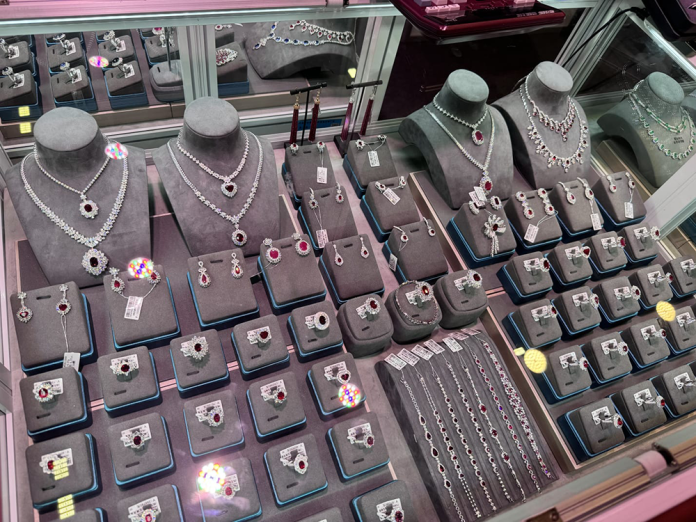The 2024 Beijing International Gold, Jewelry, and Gemstone Exhibition concluded on June 3 at the Beijing Exhibition Center. The event featured exhibitors not only from major Chinese cities such as Beijing, Shanghai, Shenzhen, and Guangzhou but also from various international jewelers. Chinese consumers showed consistent enthusiasm for gold, jade, pearls, and other precious items. Notably, there was a marked interest in colored gemstones, with a significant crowd around the booths of exhibitors from Pakistan and Sri Lanka.
“The quality of colored gemstones from Pakistan and Sri Lanka caught my eye, so I stopped to ask about the prices. I might find something good to buy,” a consumer shared with the reporter.
In 2023, the total import and export value of China’s jewelry industry reached a record high of $145.334 billion, an increase of 8.62% year-on-year. Chinese consumers show a strong interest in gold and silver jewelry products for both their aesthetic and investment value. Additionally, Pakistan’s exports of gems and precious stones to China saw a 47 percent increase in 2023, indicating growing recognition of the quality of Pakistani gemstones among Chinese buyers.
Muhammad Amjad, the owner of PIEDRA, a Pakistani colored gemstone company, brought emeralds, aquamarines, and other gems from Peshawar to the exhibition. “I came to China in 2006 and have been in the colored gemstone business ever since. The reason for choosing to do business in China is simple: the good relationship between the two countries and the strong purchasing power of Chinese consumers. My partners here have never deceived me, which I value highly. Although sales have fluctuated in the past few years due to various factors, the market is now recovering, and I am very confident,” Muhammad Amjad told the reporter.
Since 2023, demand for colored gemstones in China has been steadily expanding, supplementing the traditional safe-haven asset of gold. According to market research by the China Gems and Jade Association (Beijing) Fund Management Co., the average price increase for colored gemstones across all categories in China during the first half of 2023 ranged between 30% and 50%. Prices for larger or relatively rare gems surged by as much as 100% to 150%.
“Although the demand for precious-colored gemstones hasn’t surged as dramatically as that for gold, it has remained relatively stable, with a consistent customer base. In recent years, with the rise of e-commerce and social media platforms, younger consumers have become increasingly accepting of colored gemstones,” said Ma Xiaozhong, a jeweler from China. Ma owns Muny Asia Jewellery, a colored gemstone company in Beijing, and has been in the business for over 20 years. “We source raw gemstones from around the world, process them domestically, and sell them both locally and in Western markets. Unfortunately, we haven’t established stable cooperation with Pakistan.”
When asked why, Ma provided a cautious response: “Pakistan’s gemstone industry has a longer history than China’s. In Peshawar’s gemstone market, you can find family businesses that have been around for a century. It’s difficult for outsiders to enter the market, and it’s not easy for foreigners to do business there. Pakistan’s gem certification institutions aren’t aligned with international standards, and some certification documents are not recognized.” Ma’s story highlights a missed opportunity.
Various indicators suggest that China, as Pakistan’s all-weather strategic partner, boasts a thriving and growing market for colored gemstones. Pakistan, with its diverse geological conditions, is rich in high-quality natural-colored gemstones. However, the two countries have not fully leveraged their friendly relations to explore the potential of this industry. Currently, a few Pakistani companies with stable cash flow, gemstone resources, and professional design teams have the necessary conditions to enter the Chinese market. In contrast, Peshawar-based traders, who rely on bulk sales, face numerous challenges in establishing deeper cooperation with China.
From the perspective of a brand jeweler, Muhammad Amjad shared some insights with us: “One problem is that Pakistan lacks effective advertising methods. Chinese businessmen are smart; they use short video platforms like TikTok and Kuaishou to promote their brands or unique national gemstones, leaving a lasting impression on consumers and even driving up product prices. In contrast, we can only wait in Peshawar for buyers from other countries.”
Indeed, lacking product visibility hampers sales, especially for goods with financial attributes, but visibility must be predicated on quality. Muhammad added, “Secondly, we urgently need to establish a gem certification institution that meets international standards. Our laboratories don’t meet these standards, and traders from around the world label our gems with other countries’ tags and sell them to high-end jewelry brands like Cartier. This harms us.”
Recently, Pakistani Prime Minister Shehbaz Sharif emphasized in a statement from his office, “Efforts should be made to obtain international certifications for precious stones and the products made from them, and to ensure Pakistani representation in global exhibitions.”
Furthermore, Pakistan’s gemstone export industry faces significant hurdles due to a lack of financial infrastructure. In Azad Market Namak Mandi, gem trader Abdul Ahad highlighted key issues: “One major issue is payment; many of our clients prefer PayPal, which is not available in Pakistan. Another issue is the lack of DHL branches, leading to slow shipping times of 15-20 days, despite using DHL’s name.”
Another pressing challenge is gemstone cutting. High-quality cutting significantly enhances the value of gemstones, yet Pakistan’s gemstone cutting sector remains underdeveloped. The equipment and methods used are outdated, resulting in lower-quality cuts. “The cutting techniques and tools in Pakistan are outdated. We lack modern machinery and rely on traditional hand-cutting methods, which cannot meet international market demands for modern cuts,” Abdul Ahad added.
Two weeks ago, Prime Minister Shehbaz Sharif emphasized in an office statement the need to develop the country’s gems and precious stones sector, urging authorities to take steps to grant it the status of an industry. Under the trade bridge established by the China-Pakistan Economic Corridor (CPEC), the exchange of technology and equipment is inevitable. Colored gemstones could potentially become a cornerstone of Pakistan’s economic revitalization.


